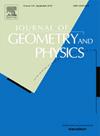Eguchi-Hanson harmonic spinors revisited
IF 1.2
3区 数学
Q1 MATHEMATICS
引用次数: 0
Abstract
We revisit the problem of determining the zero modes of the Dirac operator on the Eguchi-Hanson space. It is well known that there are no normalisable zero modes, but such zero modes do appear when the Dirac operator is twisted by a connection with normalisable curvature. The main novelty of our treatment is that we use the established formalism of spin-c spinors as complex differential forms, which makes the required calculations remarkably straightforward. In particular, to compute the Dirac operator we never need to compute the spin connection. As a result, we are able to reproduce the known normalisable zero modes of the twisted Eguchi-Hanson Dirac operator by relatively simple computations. We also collect various different descriptions of the Eguchi-Hanson space, including its construction as a hyperkähler quotient of with the flat metric. The latter illustrates the geometric origin of the connection with curvature used to twist the Dirac operator. To illustrate the power of the formalism developed, we generalise the results to the case of Dirac zero modes on the Ricci-flat Kähler manifolds obtained by applying Calabi's construction to the canonical bundle of .
重新审视了Eguchi-Hanson谐波旋量
我们重新讨论了Eguchi-Hanson空间上Dirac算子零模的确定问题。众所周知,没有可归一化的零模,但当Dirac算子被具有L2可归一化曲率的U(1)连接扭曲时,确实会出现这样的零模。我们的处理的主要新颖之处在于,我们使用已建立的自旋-c旋量的形式作为复杂的微分形式,这使得所需的计算非常简单。特别地,为了计算狄拉克算子,我们不需要计算自旋连接。结果,我们能够通过相对简单的计算再现扭曲Eguchi-Hanson Dirac算子的已知可归一化零模。我们还收集了Eguchi-Hanson空间的各种不同描述,包括其作为C4与平面度量的hyperkähler商的构造。后者说明了用于扭曲狄拉克算子的L2曲率连接的几何起源。为了说明所开发的形式主义的力量,我们将结果推广到ricci平面Kähler流形上的Dirac零模的情况,该结果是通过将Calabi构造应用于CPn的正则束而得到的。
本文章由计算机程序翻译,如有差异,请以英文原文为准。
求助全文
约1分钟内获得全文
求助全文
来源期刊

Journal of Geometry and Physics
物理-物理:数学物理
CiteScore
2.90
自引率
6.70%
发文量
205
审稿时长
64 days
期刊介绍:
The Journal of Geometry and Physics is an International Journal in Mathematical Physics. The Journal stimulates the interaction between geometry and physics by publishing primary research, feature and review articles which are of common interest to practitioners in both fields.
The Journal of Geometry and Physics now also accepts Letters, allowing for rapid dissemination of outstanding results in the field of geometry and physics. Letters should not exceed a maximum of five printed journal pages (or contain a maximum of 5000 words) and should contain novel, cutting edge results that are of broad interest to the mathematical physics community. Only Letters which are expected to make a significant addition to the literature in the field will be considered.
The Journal covers the following areas of research:
Methods of:
• Algebraic and Differential Topology
• Algebraic Geometry
• Real and Complex Differential Geometry
• Riemannian Manifolds
• Symplectic Geometry
• Global Analysis, Analysis on Manifolds
• Geometric Theory of Differential Equations
• Geometric Control Theory
• Lie Groups and Lie Algebras
• Supermanifolds and Supergroups
• Discrete Geometry
• Spinors and Twistors
Applications to:
• Strings and Superstrings
• Noncommutative Topology and Geometry
• Quantum Groups
• Geometric Methods in Statistics and Probability
• Geometry Approaches to Thermodynamics
• Classical and Quantum Dynamical Systems
• Classical and Quantum Integrable Systems
• Classical and Quantum Mechanics
• Classical and Quantum Field Theory
• General Relativity
• Quantum Information
• Quantum Gravity
 求助内容:
求助内容: 应助结果提醒方式:
应助结果提醒方式:


